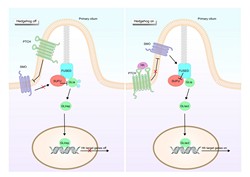Insight into sonic hedgehog signalling
The sonic hedgehog (Shh) pathway is an important developmental signalling pathway implicated in over 50 % of cancers. The key mediator of the pathway in mammals is the Shh protein. During its maturation, Shh is post-translationally modified in the endoplasmic reticulum and transported to the cell membrane, where it gets released into the surrounding area. Shh forms multimeric complexes that can induce genes involved in the development of target cells. Despite the emerging impact of Shh on cancer development, there are crucial aspects of the Shh pathway that need to be elucidated. Scientists of the EU-funded CB-HEDGEHOG (A chemical biology approach to understand the release of sonic hedgehog) project set out to investigate the mechanism of release of the Shh signalling complex by the expressing cell. The team focused on the effect of the glycoprotein Scube 2 on the Shh release mechanism. Scube2 is known to be recruited to cell-bound Shh substrates and regulate their turnover. Scientists generated a proteomics approach that enabled the quantification of the turnover kinetics of cell surface proteins including Shh. In another part of the project, they employed highly multidisciplinary approaches to investigate small molecule inhibitors (RUSKI compounds) of the Shh acyltransferase to selectively prevent activation of Shh. Through a synthetic strategy, they generated and identified stereoisomers of RUSKI compounds with increased selectivity. Additionally, they reported on- and off-target effects of published RUSKI inhibitors and performed a comprehensive structure activity relationship study. Collectively, the deliverables and tools of the CB-HEDGEHOG project are expected to significantly aid future studies on shh signalling. Considering the implication of the pathway in cancer, it is of vital importance to fully understand shh signalling to design effective therapies and novel diagnostic approaches.







